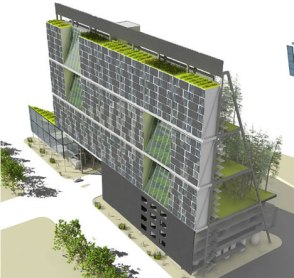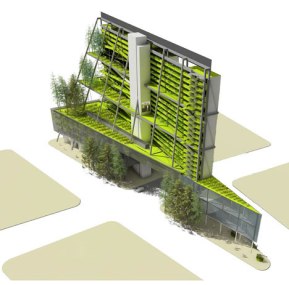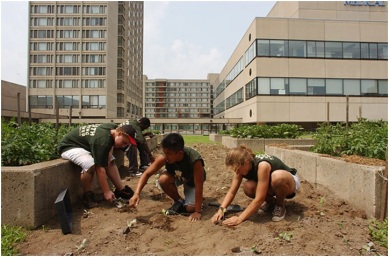The IMF (International Monetary Fund) released statistics, as of 2007, demonstrating nearly 30% of the nation’s poor reside in urban dwellings. The majority (80.7% ) of our nation’s population resides in urban areas (US Census Bureau). Yet, only 3 percent, or 61 million acres, of the US has been utilized for urban development (Nickerson, Ebel, Borchres, Carriazo). Why am I spitting out these facts? Well I’m about to dwell in those depressing despotic corners of the pessimistic environmentalist’s mind. Although, I’m not here to mope about the sad future. No, I want to report on the issues of food and land scarcity, the efforts of alternative agriculture production in urban areas, and conclude with my spiel about the right to food.
It can be argued that cities are more sustainable than rural areas due to the complete and centralized system of facilities and operations that allow a people to live in a relatively small area in which much of the activity is densely concentrated. However, consider one variable to the vitality of city life. In the research that calculated the 3% of land is utilized by the urban areas, approximately 30% is utilized by farmland. The diagram below deomonstrates the correlation between the concentration of urban areas (in green) and the rise of market prices for crops (blue meaning higher cost, brown meaning average cost).
Interestingly, there are areas of high crop production still have a higher market value for food (the Southeast for example); likewise, there are areas of dense urbanization that do not reflect this positive trend (Southwest and California for example). The overall relationship here is that in areas of high urban density food prices tend to increase due to demand and competition for land. This correlation is analyzed in an article by Choice Magazine, “The influence of Urban Areas on Farmland Values.” To reinforce this competition for land, this article published the price per acreage in rural and urban-influenced areas of the United States.
What can be seen is a rise in price per acre both in rural and urban locations, and how prices of land in urban areas are much higher than rural areas. “Urban influence is associated with land values being ‘bid up’ by competing land use activities, including residential and commercial development” (Kuethe, Ifft, Morehart).The price to farm near urban areas—where demand for local foods is rising and where there is a limitless number of bellies to fill—demonstrates that in the economic world it is gamble of an endeavor.
Maybe, if I flex these facts a bit, you could see how a city is less sustainably sound as you may have thought. Urban areas rely on outsourced (as in outside city limits) food production to meet the demand for food. Furthermore, this reliance is so demanding that city residents are willing to front the cost. Well, some of them are. Remember how I mentioned earlier that 30% of residents in urban areas are impoverished? This percentage of the population cannot always afford food and some have little access to quality food. Many impoverished people have to rely on affordable means to be fed. Fed, not nourished, and also not I did not say well fed.
These are the issues of food scarcity and food deserts in city areas. Food scarcity refers to the inability to supply food to a population (more so the case in developing nations). A food desert refers to an area, in a developed nation, in which a population has little to no access to affordable, quality food. Food deserts are not only found in urban areas (where the nearest “food source” maybe the corner market or gas station), but also in rural areas in which a box store grocery is the only source of food in a 25-mile radius.
Now, let’s combine the issues of land scarcity and food deserts in the form of urban agriculture. How does one turn a concrete jungle into the Gardens of Babylon? Land is scarce in urban areas. When I was in D.C. last spring, most homes were connected for entire block and yards consist of 12’ by 6’ spaces. Most metropolitan areas do not allow easy access to starting a garden. The opportunity for the individual resides in participating in community gardens or, more drastically, guerilla gardening. However, what about food production beyond a neighborhood scale, as in, areas with population densities as concentrated as 10,000+ people per square mile? In other words, how can city planners and developers establish a farm smack dab in the middle of the city?
Cities have become creative with the space they have to utilize. City planners are asking architects to design buildings that incorporate vertical farming into its structure. Vertical farming refers to the ability to cultivate plant or animals within (or outdoor) a vertical structure (as in a skyscraper or tower). This form of alternative agriculture is, by far, the most fascinating to me in regards to its elaborate and heavily complicated applications. Below is a rendition of a building designed for Seattle that would be both utilized for its office space and its agricultural space.
Tearing down a building is more than likely not the probable alternative. People must use what is already present. In this case below, Food Project is repurposing a roof top in Lincoln, Massachusetts to create an edible roof space. Roof top gardens, in addition to growing food, are effective ways to reduce rain runoff, energy costs due to temperature fluctuations (as roof top gardens act as insulation), and the Heat Island Effect. Much in the same way, many parking lots are becoming “renovated” and turned into community gardens in order to salvage as much unused space as possible.
The final method I want to present is hydroponic farming. Our internship has visited two hydroponic facilities here in Tennessee, King’s Hydrofarm and Greater Growth Aquaponics. Every hydroponic facility has its individual differences, but the idea behind it is a condition-controlled, closed system in which water and nutrients are cycled and recycled to cultivate edible food in soilless conditions all year round. One example is the NFT (nutrient film technique): Fish (a step-up form of NFT known as aquaculture) is grown and used for both its meat and its fertilizer (fish waste), the fish waste (at this point not prohibited by the USDA and is regarded as safe to have present as the plant is growing) is ran through the water systems to water and nourish vegetables that are growing in a hydroponic medium. Compost can be made through a process known as vermiculture (utilizing worms to breakdown food waste, compost, etc. resulting in a fertile amendment) is incorporated to create a worm casting production and a food source for the fish (a supplement to create a perfectly closed-system instead of feeding the fish food derived from corn or wheat). There are countless other methods such as known as the Dutch Bucket System is used for vertical productions (i.e. growing tomatoes for a prolong season).
Stacking strawberry plants, or other various plants, and using a method such as drain and flow (in which water is applied to a top container and the run off flows down the column) reduces required space to grow crops. In a way it is a small scale version of vertical farming. There is also the folkewall (named after the Swedish biologist/farmer Folke Günther) which is a form of vertical gardening and water purification in which grey water is circulated through a wall arranged with plants—both nourishing the plants and filtering the water—and made potable after the process is finished (I believe it is much more extensive than that, but I got to keep it short). The downside to all this is the necessity to introduce natural pollinators (especially in the case of strawberries and cherry tomatoes). For this reason, most hydroponic facilities will only produce plants that can be easily accommodated with the current technologies.
To briefly touch on hydroponics here is a great overall video:
For there to be cities that are less reliant on outside food source and function sustainably to produce food within its own limits then urban agricultural systems need to be incorporated. I do not like to bring politics to the table, but sometimes it is necessary; because right now, even here in Knoxville, sometimes the only sources of food are the bodega down the street or the gas station on the way to work. Safe, healthy food should not be separated by a higher price per pound. Food should not discriminatory element in society. there should be no excuse as to not be able to solve the food desert issue within cities and the surrounding areas as technologically advanced as our society is. Regardless of whatever socioeconomic background you may be or wherever you live food is a right and not a privilege.




